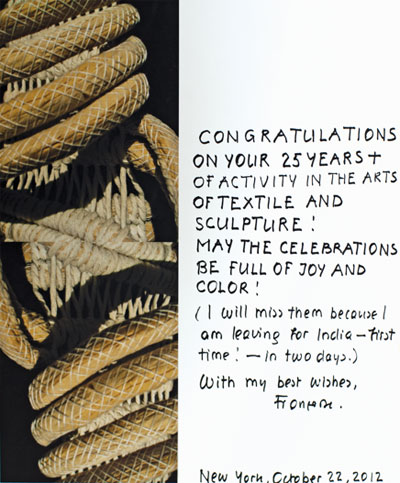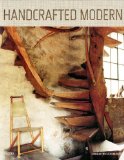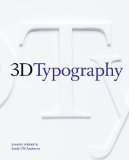 Earlier this year, Françoise Grossen sent bga these congratulations on our 25th anniversary. Grossen’s remarkable contributions to the field predate ours. In 1972, her work was featured in, “Rope Art: A new form fit to be tied,” in Life Magazine in an article on the exhibition Deliberate Entanglements. “Françoise Grossen, a Swiss better at knotting than entomology, concocted a 20-foot Inch Worm” the magazine wrote. “Some viewers at New York’s Museum of Contemporary Crafts thought it moved.” (Life Magazine, December 1, 1972, pp.86-90). This year, Grosssen’s work, Ahnen Galerie, 10 braided bundles of dyed manila rope with appendages, 13 x 116 x 92 inches, was acquired by the Racine Art Museum. Ahnen Galerie is now on display in High Fiber: Recent Large-Scale Acquisitions in Fiber, http://www.ramart.org/content/high-fiber-recent-large-scale-acquisitions-fiber, at the Racine Museum of Art through January 20, 2013.
Earlier this year, Françoise Grossen sent bga these congratulations on our 25th anniversary. Grossen’s remarkable contributions to the field predate ours. In 1972, her work was featured in, “Rope Art: A new form fit to be tied,” in Life Magazine in an article on the exhibition Deliberate Entanglements. “Françoise Grossen, a Swiss better at knotting than entomology, concocted a 20-foot Inch Worm” the magazine wrote. “Some viewers at New York’s Museum of Contemporary Crafts thought it moved.” (Life Magazine, December 1, 1972, pp.86-90). This year, Grosssen’s work, Ahnen Galerie, 10 braided bundles of dyed manila rope with appendages, 13 x 116 x 92 inches, was acquired by the Racine Art Museum. Ahnen Galerie is now on display in High Fiber: Recent Large-Scale Acquisitions in Fiber, http://www.ramart.org/content/high-fiber-recent-large-scale-acquisitions-fiber, at the Racine Museum of Art through January 20, 2013.
Looking Forward/Looking Back: Françoise Grossen
Art into Type: Books We Talked Up in 2010
 Last year saw several books published that we recommended to clients and purchased for family and friends. Among these were Handcrafted Modern: At Home with Mid-century Designers by Leslie Williamson, a collection of photographs of beautiful, iconic, and undiscovered mid-century interiors, including the homes of Russel Wright, George Nakashima, Harry Bertoia, Charles and Ray Eames, and Eva Zeisel, among others. Williamson’s photographs show these creative homes as they were lived in by their designers: Walter Gropius’ historic Bauhaus home in Massachusetts; Albert Frey’s floating modernist aerie on a Palm Springs rock outcropping; and Wharton Esherick’s completely handmade Pennsylvania house, from the organic hand-carved staircase to the iconic furniture.
Last year saw several books published that we recommended to clients and purchased for family and friends. Among these were Handcrafted Modern: At Home with Mid-century Designers by Leslie Williamson, a collection of photographs of beautiful, iconic, and undiscovered mid-century interiors, including the homes of Russel Wright, George Nakashima, Harry Bertoia, Charles and Ray Eames, and Eva Zeisel, among others. Williamson’s photographs show these creative homes as they were lived in by their designers: Walter Gropius’ historic Bauhaus home in Massachusetts; Albert Frey’s floating modernist aerie on a Palm Springs rock outcropping; and Wharton Esherick’s completely handmade Pennsylvania house, from the organic hand-carved staircase to the iconic furniture.
 Another favorite volume of ours was 3-D Typography. We added “text” to the title of this blog so that we could cover two things we are passionate about: art that involves text and interesting books. 3-D Typography, which includes work by Gyöngy Laky and dozens of other artists who have created lettering out of everything from shopping carts and toilet paper to toothpaste and pinched flesh, fits both criteria. The book’s creation was serendipitous. The authors, Jeanne Abbink and Emily CM Anderson looked at three-dimensional type in the course on a redesign of American Craft magazine in 2007.
Another favorite volume of ours was 3-D Typography. We added “text” to the title of this blog so that we could cover two things we are passionate about: art that involves text and interesting books. 3-D Typography, which includes work by Gyöngy Laky and dozens of other artists who have created lettering out of everything from shopping carts and toilet paper to toothpaste and pinched flesh, fits both criteria. The book’s creation was serendipitous. The authors, Jeanne Abbink and Emily CM Anderson looked at three-dimensional type in the course on a redesign of American Craft magazine in 2007.
 Long overdue was the first comprehensive survey of modern craft in the United States, Makers: A History of American Studio Craft, by Janet Koplos and Bruce Metcalf. Makers follows the development of studio craft–objects in fiber, clay, glass, wood, and metal–from its roots in 19th-century reform movements to the rich diversity of expression at the end of the 20th century. More than 400 illustrations — including two photographs by Tom — complement this chronological exploration of the American craft tradition. Keeping as their main focus the objects and the makers — including Lenore Tawney, Ed Rossbach, Kay Sekimachi, Katherine Westphal, François Grossen, Lia Cook, Warren Seelig, Arturo Sandoval, Gyöngy Laky, Dorothy Gill Barnes, Clare Zeisler, Anni Albers, Lillian Elliott, Helena Hernmarck, Norma Minkowitz and Trude Guermonprez — the authors offer a detailed analysis of major works and discuss education, institutional support and the philosophical underpinnings of craft.
Long overdue was the first comprehensive survey of modern craft in the United States, Makers: A History of American Studio Craft, by Janet Koplos and Bruce Metcalf. Makers follows the development of studio craft–objects in fiber, clay, glass, wood, and metal–from its roots in 19th-century reform movements to the rich diversity of expression at the end of the 20th century. More than 400 illustrations — including two photographs by Tom — complement this chronological exploration of the American craft tradition. Keeping as their main focus the objects and the makers — including Lenore Tawney, Ed Rossbach, Kay Sekimachi, Katherine Westphal, François Grossen, Lia Cook, Warren Seelig, Arturo Sandoval, Gyöngy Laky, Dorothy Gill Barnes, Clare Zeisler, Anni Albers, Lillian Elliott, Helena Hernmarck, Norma Minkowitz and Trude Guermonprez — the authors offer a detailed analysis of major works and discuss education, institutional support and the philosophical underpinnings of craft.
 Another very special volume from 2010 is Written Weed, by Marian Bijlenga, published by Hein Elferink. This exquisite book includes 111 paste-ups / collages by the artist made of dried leaves, grasses and seeds. The images are like handwriting, Chinese characters, the letters of an alphabet. In order to emphasize the graphic quality of these works, the book is published in black/white. Only 400 copies were produced; each is numbered and signed. You can order it from browngrotta arts for $185.00
Another very special volume from 2010 is Written Weed, by Marian Bijlenga, published by Hein Elferink. This exquisite book includes 111 paste-ups / collages by the artist made of dried leaves, grasses and seeds. The images are like handwriting, Chinese characters, the letters of an alphabet. In order to emphasize the graphic quality of these works, the book is published in black/white. Only 400 copies were produced; each is numbered and signed. You can order it from browngrotta arts for $185.00
 Though it was written in 2009, I didn’t discover The Bird Catcher, by Laura Jacobs, until last year. I loved it and ordered copies for several friends. It’s a tender story of grief and healing in the big city. But it was the detailed description of the protagonist’s window displays for a high-end department store and the evolution of her closest friend’s craft gallery — including a display of elegantly crafted goblets — that I most appreciated.
Though it was written in 2009, I didn’t discover The Bird Catcher, by Laura Jacobs, until last year. I loved it and ordered copies for several friends. It’s a tender story of grief and healing in the big city. But it was the detailed description of the protagonist’s window displays for a high-end department store and the evolution of her closest friend’s craft gallery — including a display of elegantly crafted goblets — that I most appreciated.
Search
Subscribe2
Recent Posts
- July 16, 2025
- July 10, 2025
- July 2, 2025
Pages
blogroll
Archives
- July 2025
- June 2025
- May 2025
- April 2025
- March 2025
- February 2025
- January 2025
- December 2024
- November 2024
- October 2024
- September 2024
- August 2024
- July 2024
- June 2024
- May 2024
- April 2024
- March 2024
- February 2024
- January 2024
- December 2023
- November 2023
- October 2023
- September 2023
- August 2023
- July 2023
- June 2023
- May 2023
- April 2023
- March 2023
- February 2023
- January 2023
- December 2022
- November 2022
- October 2022
- September 2022
- August 2022
- July 2022
- June 2022
- May 2022
- April 2022
- March 2022
- February 2022
- January 2022
- December 2021
- November 2021
- October 2021
- September 2021
- August 2021
- July 2021
- June 2021
- May 2021
- April 2021
- March 2021
- February 2021
- January 2021
- December 2020
- November 2020
- October 2020
- September 2020
- August 2020
- July 2020
- June 2020
- May 2020
- April 2020
- March 2020
- February 2020
- January 2020
- December 2019
- November 2019
- October 2019
- September 2019
- August 2019
- July 2019
- June 2019
- May 2019
- April 2019
- March 2019
- February 2019
- January 2019
- December 2018
- November 2018
- October 2018
- September 2018
- August 2018
- July 2018
- June 2018
- May 2018
- April 2018
- March 2018
- February 2018
- January 2018
- December 2017
- November 2017
- October 2017
- September 2017
- August 2017
- July 2017
- June 2017
- May 2017
- April 2017
- March 2017
- February 2017
- January 2017
- December 2016
- November 2016
- October 2016
- September 2016
- August 2016
- June 2016
- April 2016
- March 2016
- February 2016
- December 2015
- October 2015
- September 2015
- August 2015
- June 2015
- May 2015
- April 2015
- March 2015
- February 2015
- January 2015
- December 2014
- November 2014
- October 2014
- September 2014
- August 2014
- July 2014
- June 2014
- May 2014
- April 2014
- March 2014
- February 2014
- January 2014
- December 2013
- October 2013
- September 2013
- July 2013
- June 2013
- May 2013
- April 2013
- March 2013
- January 2013
- December 2012
- November 2012
- October 2012
- September 2012
- August 2012
- July 2012
- June 2012
- May 2012
- April 2012
- March 2012
- February 2012
- January 2012
- December 2011
- November 2011
- October 2011
- September 2011
- August 2011
- July 2011
- June 2011
- May 2011
- April 2011
- March 2011
- February 2011
- January 2011
- December 2010
- November 2010
- October 2010
- September 2010
- August 2010
- July 2010
- June 2010
- May 2010
- April 2010
- March 2010
- February 2010
- January 2010
- December 2009
- November 2009
- October 2009
- September 2009
- August 2009
Categories
- Acquisitions
- Aldrich Museum of Contemporary Art
- Allies for Art
- An Unexpected Approach
- Anniversary
- Architecture
- Art
- art + identity
- Art Assembled
- Art Materials
- art money
- Art Preview
- Art Textiles
- artist
- Artsy
- Awards
- bamboo
- Basketmakers
- Basketry
- Behind the Scenes
- Blue/Green
- Book Recommendations
- Books
- Catalogs
- Ceramics
- Charity
- Classes
- Collage
- Collectors
- Commentary
- Commission
- Commissions
- Danish Tapestry
- DIY
- Eco-Art
- Exhibitions
- Fashion
- Fiber Future
- Fiber Sculpture
- Film
- Galleries
- Gifts
- Guest Post
- History
- In the News
- Installations
- Japandi
- Japanese Art
- Japanese Ceramics
- Lectures
- Mixed Media
- Museums
- New This Week
- New York
- Obituary
- Obiturary
- Outdoors
- Paper
- Philadephia Museum of Art
- Photography
- Politics
- Pop-Up Exhibition
- Press
- Process Notes
- Sculpture
- SOFA
- Sweepstakes
- Tapestry
- tate modern
- Technology
- Text Art
- Travel
- Uncategorized
- Volume 50: Chronicling Fiber Art for Three Decades
- White
- White Art
- Who Said What
- Wood
- Workshops
Tags
Adela Akers art assembled Basketry browngrotta arts Carolina Yrarrázaval Caroline Bartlett Dorothy Gill Barnes Ed Rossbach Gudrun Pagter Gyöngy Laky Heidrun Schimmel Helena Hernmarck Hisako Sekijima Jane Balsgaard Jennifer Falck Linssen Jin-Sook So Jiro Yonezawa John McQueen Karyl Sisson Kay Sekimachi Kiyomi Iwata Kyoko KumaI Lawrence LaBianca Lenore Tawney Lewis Knauss Lia Cook Magdalena Abakanowicz Marian Bijlenga Mariette Rousseau-Vermette Mary Giles Mary Merkel-Hess Nancy Koenigsberg Nancy Moore Bess Naoko Serino Naomi Kobayashi Norma Minkowitz Rachel Max Randy Walker Sheila Hicks Stéphanie Jacques Sue Lawty Tamiko Kawata Tapestry Wendy Wahl Yasuhisa KohyamaAbout browngrotta.com
blogroll
reboot
site-ings
who's showing where
Subscribe
Pages
Archives
Calendar
